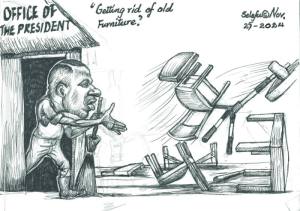All non-mining sectors of the economy recorded positive growth in the second quarter of the year, helping to limit the impact of the protracted diamond slump, as the country continues to hope for a recovery.
Statistics Botswana figures released last week indicate that real Gross Domestic Product (GDP), a measure of economic activity, slowed to a negative 0.5 percent year on year in the second quarter, after a -5.3 percent performance in the first quarter. Two successive quarters of negative economic activity are a technical recession, but for Botswana, the impact could have been steeper without the contribution of the non-mining sector.
According to the data agency, the contribution of mining and quarrying activities contracted by 16.5% in the second quarter, weighed down by base metals as well as diamonds.
“Diamond production in carats decreased by 18.7% in the second quarter of 2024,” Statistics Botswana researchers stated. “The diamond market appetite has affected the commodity demand across the world. This, therefore, impacts negatively on the production and sale of diamonds. “Plant refurbishment affected the production of copper and nickel.”
Diamonds, the economy’s single most important commodity, have been in a protracted downturn stretching back to the third quarter of last year. The diamond downturn has been the worst in at least five years, driven by underlying factors such as uncertainties in the crucial United States market, a surge in the popularity of lab-growns, lower-than-expected recovery in China and the distaste for natural diamonds some consumers felt as sanctioned Russian stones continued trading in the market.
The slump manifested in higher inventory levels of natural diamonds at the retail end, with the oversupply moving to the midstream and pressurising the cutting and polishing firms, mainly based in India. These firms have since asked the upstream miners such as Debswana to reduce their production and allow demand to recover elsewhere in the diamond pipeline.
This year, De Beers has cut its production targets for 2024 three times, while also suspending some auctions. The state diamond company, Okavango Diamond Company, has also reportedly suspended an auction, to support the improvement in demand.
The potential shock to local GDP figures in the second quarter was ameliorated by all other non-mining sectors which recorded growth rates of 0.3 percent and above each. According to Statistics Botswana, non-mining GDP increased by 4.2 percent in the second quarter of 2024 compared to 3.8 percent registered in the same quarter of the previous year.
Key sectors recording growth included manufacturing which rose 2.8 percent, construction which increased 3.4 percent, accommodation and food services (4.5 percent) as well as finance, insurance and pension funding (3.8 percent), all underpinned by stable electricity and water supply. Real value added by the electricity sector rose by 48.2% in the second quarter, as opposed to a decrease of 57.4% registered in the corresponding quarter of 2023, while the water sector recorded 2.2 percent growth in real value added in the second quarter of 2024.
Even the agriculture sector, which is traditionally a weak performer, registered 0.3 percent growth in the second quarter.
“The overall performance was mainly due to the increase in real value-added livestock farming by 1.5 percent. “The growth in the livestock farming sub-industry was attributable to the increased number of cattle marketed during the quarter under review. “Cattle sold to Botswana Meat Commission registered a significant growth of 10.3%,” researchers noted.
Commenting on the figures, Dr Lovemore Taonezvi, a lecturer in Economics at BA ISAGO University who holds a PhD in Economics, told BusinessWeek said the second quarter performance shows a mixed picture of the economy.
“On the one hand, the mining sector, especially diamonds, copper, and nickel, significantly pulled down growth in the second quarter. “The real value added from the mining sector as a whole contracted by 16.5%, which is a substantial hit to the economy given the importance of the sector. “However, other sectors showed resilience, with most industries recording positive growths of over 0.3 percent. “This suggests that while the economy is facing challenges, particularly in the mining sector, other parts of the economy are holding up relatively well and could help cushion the broader economic impact,” he said.
Dr Taonezvi added: "The overall contraction of 0.5 percent on a year-on-year basis in the second quarter indicates that while the economy is struggling, especially compared to 2023, it is not in a dire state." “The diversified growth in non-mining sectors provides some hope that the economy can stabilise, though the heavy reliance on mining makes the situation precarious if the downturn in commodity markets persists," he said. “This further highlights the urgent need to diversify the economy and cushion it from external shocks related to the mining sector.”








